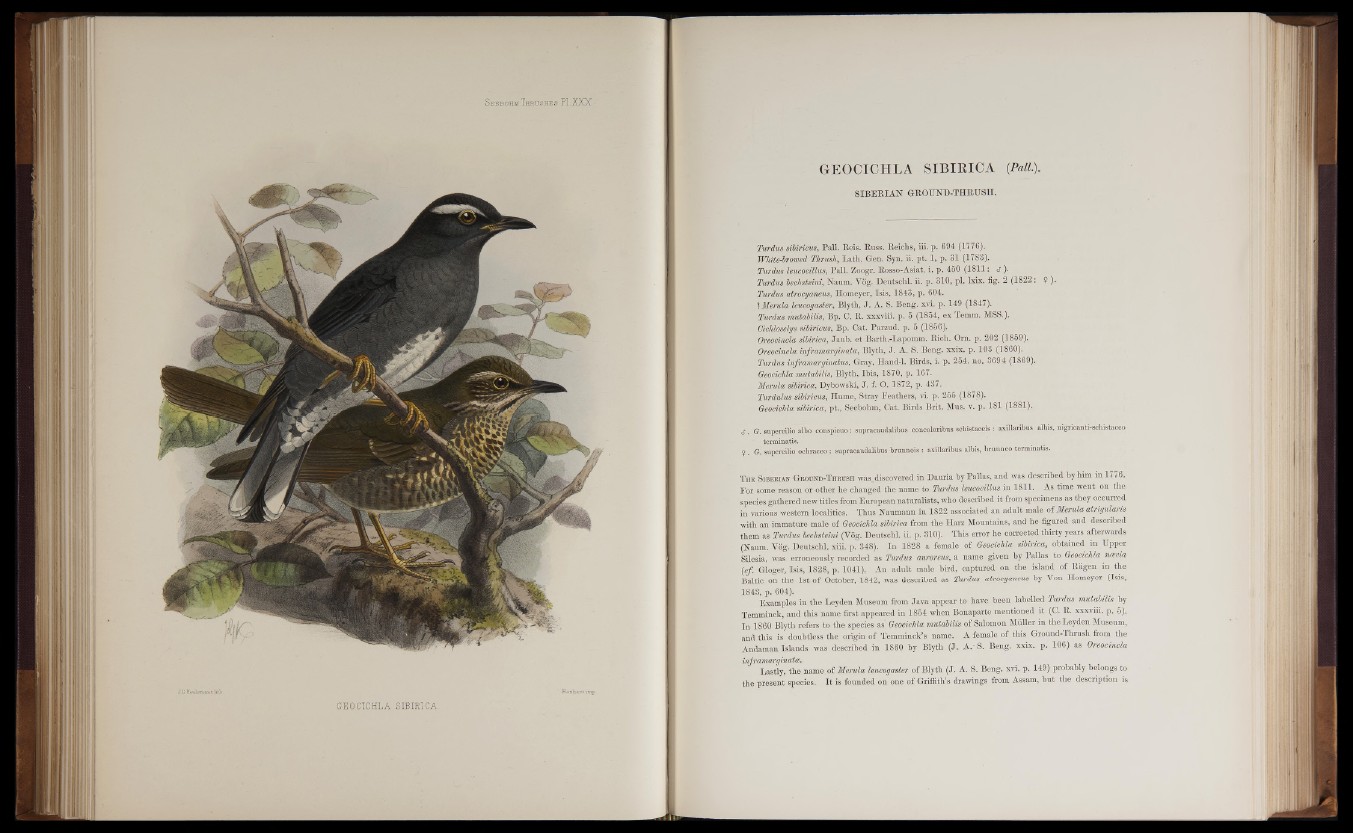
GEOCIOHLA SIBIRICA {Pall.).
S IB E R IA N G R O U N D -T H R U S H .
Turdus sibiricus, Pall. Reis. Russ. Reichs, iii. p. 694 (1776),
White-browed Thrush, Lath. Gen. Syn. ii. pt. 1, p. 31 (1783).
Turdus leucocillus, Pall. Zoogr. Rosso-Asiat. i. p. 450 (1811: 6 ).
Turdus bechsteini, Naum. Vog. Deutschl. ñ. p.-310, pi. lxix. fig. 2 (1822: $ ).
Turdus atrocyaneus, Homeyer, Isis, 1843, p. 604.
\ Merula leucogaster, Blyth, J. A. S.. Beng. xvi. p. 149 (1847).
Turdus mutabiiis, Bp. C. R. xxxviii. p. 5 (1854, ex Temm. MSS.).
Cichloselys sibiricus, Bp. Cat. Parzud. p. 5 (1856).
Oreocincla sibirica, Jaub. et Barth.-Lapomm. Rich. Orn. p. 202 (1859),
Oreocinclainframarginata, Blyth, J. A. S. Beng. xxix. p. 103 (ISfiO).
Turdus inframarginatus, Gray, Hand-1. Birds, i. p. 254. no. 3694 (1869).
Geocichla mutabiiis, Blyth, Ibis, 1870, p. 167.
Merula sibirica, Dybowski, J. f. O. 1872, p. 437.
Turdulus sibiricus, Hume, Stray Feathers, vi. p. 255 (18/8).
Geocichla sibirica, pt., Seebohm, Cat. Birds Brit. Mus. v. p. 181 (1881).
c?. G. supercilio albo conspicuo: supracaudalibus concoloribus schistaceis : axillaribus albis, nigricanti-schistaceo
terminatis*
1 1 G. supercilio ochraceo : supracaudalibus bruuneis : axillaribus albis, brunneo terminatis.
T he Siberian Ground-Thrush was_discovered in Dauria by Pallas, and was described by him in 17/6.
For some reason or other he changed the name to Turdus leucocillus in 1811. As time went on the
species gathered new titles from European naturalists, who described it from specimens as they occurred
in various western localities. Thus Naumann in 1822 associated an adult male of Merula atrigularis
with an immature male of Geocichla sibirica from the Harz Mountains, and he figured and described
them as Turdus bechsteini (Vog. Deutschl. ii. p. 310). This error he corrected thirty years afterwards
(Naum. Vog. Deutschl. xiii. p. 348). In 1828 a female of Geocichla sibirica, obtained in Upper
Silesia, was erroneously recorded as Turdus auroreus, a name given by Pallas to Geocichla ncevia
{cf. Gloger, Isis, 1828, p. 1041). An adult male bird, captured on the island of Rügen in the
Baltic on the 1st of October, 1842, was described as Turdus atrocyaneus by Von Homeyer (Isis*
1843, p. 604).
Examples in the Leyden Museum from Java appear to have been labelled Turdus mutabiiis by
Temminck, and this name first appeared in 1854 when Bonaparte mentioned it (C. R. xxxviii. p. 5)..
In 1860 Blyth refers to the species as Geocichla mutabiiis of Salomon Müller in the Leyden Museum,
and this is doubtless the origin of Temminck’s name. A female of this Ground-Thrush from the
Andaman Islands was described in 1860 by Blyth (J. A .’ S. Beng. xxix. p. 106) as Oreocincla
inframarginata.
Lastly, the name.of Merula leucogaster of Blyth (J. A. S. Beng. xvi. p. 149) probably belongs to
the present species. It is founded on one of Griffith’s drawings from Assam, but the description is